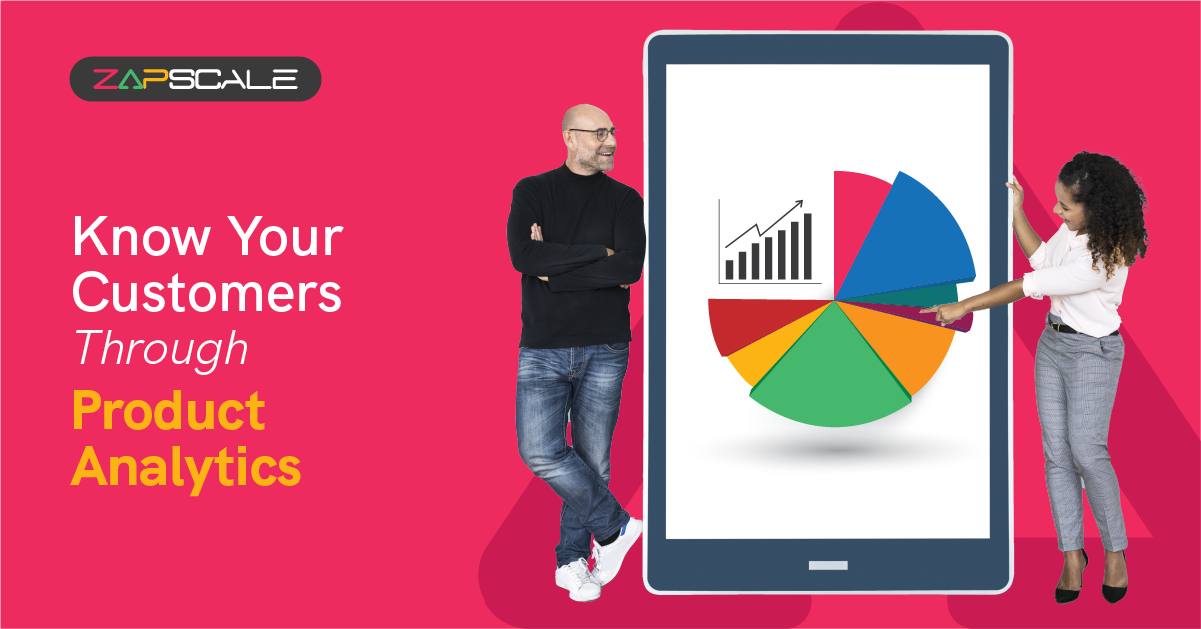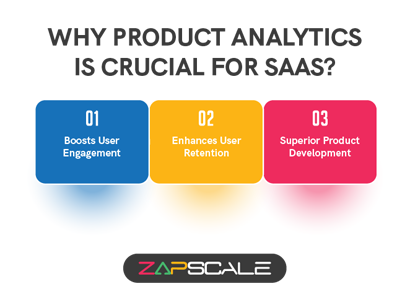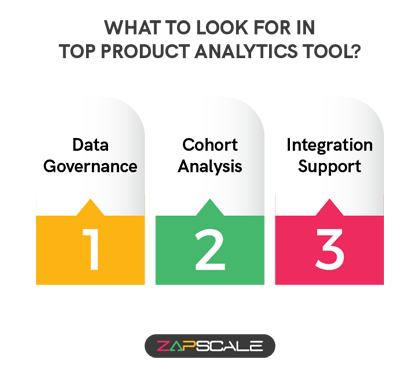CATEGORY > Customer Engagement
Your Smart Guide to Product Analytics - Tools, Examples, and More

In today's digital age, you need to be data-driven to develop awesome products for your users.
Product analytics is essential for understanding how people engage with your software.
It monitors who uses your product, how they use it, and where they face problems.
Let’s find out more about product analytics by reading below.
Introduction
Product analytics provides critical data for assessing and improving user experiences.
It enables product managers and teams to evaluate digital performance, identify problems, and connect customer behavior to long-term value.
With product analytics, you get a clear idea about your users - you know the how, where, and when.
This enables teams to maximize product utilization, discover issues, reduce churn, and customize interactions.
Capturing thorough data identifies important points of friction and opportunity, allowing you to make informed decisions rather than relying on pure guesswork.
For instance, a SaaS company can leverage product analytics to improve its onboarding process.
With valuable real-time data, the executives can identify stages where users usually call it quits and improve the same accordingly.
Significance Of Product Analytics
Product analytics has become a superior aspect in determining the success of any product.
Let’s explore what makes product analytics so crucial.

1. Boosts User Engagement
By understanding how users interact with your product, you can identify areas to improve the customer experience and make it more engaging.
Also, insights from product analytics guide data-driven decisions to enhance the customer experience.
By understanding user behavior and preferences, you can make the product more intuitive and enjoyable, increasing overall customer satisfaction and engagement.
2. Enhanced User Retention
Losing customers can cost you more than a dime.
Tracking users' activity can help you identify those who are likely to churn.
Product analytics can help you understand why customers move out and handle these issues efficiently.
By adopting data-driven changes, you can boost retention rates, keep users engaged, and reduce churn over time.

With product analytics, you become proactive in meeting their requirements and keeping them on board.
3. Superior Product Development
Product analytics gives invaluable feedback on new products and upgrades by monitoring and evaluating how people engage with them.
This data-driven strategy helps businesses better understand customer habits, preferences, and pain points.
Businesses that integrate these insights into the product development cycle can make more educated decisions about which features to improve, change, or delete.
Top 4 Benefits Of Adopting Product Analytics
Product analytics is as critical to a SaaS business as a stethoscope is to a doctor or a financial report is to an investor.
Let’s find out the top 6 advantages a SaaS business can enjoy with product analytics.

1. Better Product-Market Fit
Product analytics lets you determine whether your product meets market demands or not.
By assessing customer engagement and happiness, you may determine how well your product fits the market, allowing you to make changes to better meet customer expectations and requests.
2. Improved Customer Support
With product analytics, you can help customer support staff identify regular problems by studying user activity and finding common difficulties or pain spots.
This helps them to deliver more effective and focused assistance, resulting in faster outcomes and happier customers.
3. Real-Time Business Metrics
Product analytics makes it easier to track metrics that directly impact the business.
With product analytics, you get to track data beyond customer behavior - conversion rates, revenue generation, and so on.
4. Augmented Business Growth
Data-driven decisions based on product analytics lead to greater product-market fit, more customer satisfaction, and higher retention.
These aspects work together to drive long-term business growth and ensure the success of your product.
Product Analytics And Massive Business Transformation
Product analytics gives a new life to your business.
With the assistance of product analytics, corporations can churn out products that add value to their customers.
Let’s learn a bit more about the role played by product analytics in terms of business transformation.
1. Product Improvement
A good product ensures steady sales.
Analytics can help firms determine which features are most commonly used and which are inadequately utilized.
This facilitates data-driven decisions about where to direct development efforts, resulting in more successful product updates and innovations.
2. Cost Reduction
Analytics can point out inefficiencies in the product development and marketing processes. By tackling these inefficiencies, companies can minimize production, customer acquisition, and retention costs.
3. Efficacious Marketing Campaigns
With product analytics, you get a better idea of which marketing campaigns are doing well and which are not.
Analytics track user acquisition and measure the effectiveness of marketing campaigns. This allows you to optimize your marketing strategies and target the right audience.
4. Identification Of New Opportunities
Product analytics can help identify unmet customer needs and market gaps.
Identifying these opportunities allows firms to create new products or services, enter new markets, or diversify their offers, resulting in growth and expansion.
5. Competitive Advantage
Businesses that use product analytics can stay ahead of their competitors by adapting promptly to market shifts and consumer demands. The collected insights can lead to more inventive and user-centric products, empowering the company to stand out in the market.
How Product Analytics Can Turn Your Data Into $?
In this digital world, data is indeed the new oil.
But to make the most of your data so that it can generate impressive revenues, you must leverage the power of product analytics.
Let’s find out how product analytics can help companies improve their revenue.
1. Targeted User Acquisition
To have new money flowing in, you must acquire new customers.
With product analytics, you can smartly identify your ideal customer profile.
This allows you to target your marketing efforts more effectively, resulting in improved conversion rates.
2. Optimized Pricing Strategy
Product analytics helps businesses identify customer price sensitivity, allowing them to modify pricing models for optimum revenue without alienating customers.
Upon that, companies find the best combination of value and profitability by evaluating alternative pricing levels, resulting in both customer happiness and greater revenue.
3. Reduced Customer Churn
Losing customers is indeed like losing money. analytics can help you identify user behavior patterns that lead to churn (cancellation).
For instance, a subscription service may discover that customers leave due to unclear billing practices and then improve transparency to retain more customers.
By addressing pain points and proactively engaging at-risk users, you can protect your revenue stream and retain more customers.
4. Higher Conversions
After deploying product analytics, you can expect your revenues to reach the optimal level.
What makes that possible? Personalization.
Product analytics reveal users' preferences, actions, and purchasing history.
With this information, businesses can personalize product suggestions, special offers, and marketing messages for each user.
This personalized approach makes users feel understood and valued, improving their chances of completing a purchase or signing up for a service.
Product Analytics vs Data Analytics vs Business Intelligence
The common thread that binds concepts like product analytics, data analytics, and business intelligence is “data”, meaning they all deal with data in their ways.
Now, let's briefly figure out how they differ from each other.
1. Goal
a. Product Analytics
Improves the customer experience and optimizes product features to boost customer engagement and conversions.
b. Data Analytics
Answers precise questions to discover hidden insights in the data.
c. Business Intelligence
Provide comprehensive business health insights to enable strategic decision-making.
2. Users
a. Product Analytics
Product managers, designers, and customer experience professionals.
b. Data Analytics
Data analysts, data scientists, and researchers.
c. Business Intelligence
Executives, managers, and employees from various departments across the organization.
3. Insights
a. Product Analytics
Delivers specific actionable insights to help enhance the product promptly.
b. Data Analytics
Provides more in-depth data, yielding broader insights that may require additional investigation.
c. Business Intelligence
Provides high-level insights to help drive strategic decisions and resource allocation.
4. Source Of Data
a. Product Analytics
Derives customer behavior data from the product itself (clicks, signups, purchases).
b. Data Analytics
Can use data from any source, including sales figures, social media, and website traffic.
c. Business Intelligence
Primarily relies on internal company data like sales records, inventory, and financial statements.
Product Analytics In Action: Real-World Use Cases And Deployment Strategies
Here are some practical examples of product analytics.
1. A/B Testing
A/B testing analyzes two versions of a feature or message to determine which works better, allowing you to adapt content and features based on user responses, such as testing headlines to increase sign-ups.
2. Dashboards
Dashboards provide critical information such as active users, conversion rates, and revenue, allowing you to easily assess your product's health and identify areas for improvement.
3. Segmentation
Segmentation categorizes customers based on demographics or behavior, allowing you to analyze deviations in engagement and customize marketing and product development to each group's individual needs.
The Behind-The-Scenes Of Product Analytics Tools
Product analytics tools work in the 3 following ways as mentioned below.
1. Automatic Data Capture
Automatic data capture ensures that all user data is gathered and processed from the beginning, minimizing human tracking and incomplete datasets, saving engineering time, and eliminating the need to play catch-up.
2. Data Science Layer
A data science layer improves analytics by forecasting user flow concerns, directing teams to critical findings, and uncovering hidden phases. It enables more informed decisions and better outcomes.
3. Integrated Session Replays
Integrated session replays reveal exactly what users view, which aids in identifying friction areas and comprehending feature usage. They provide visual context to data, allowing quantitative and qualitative insights to be aligned without the use of several tools.
Beyond The Clicks - Understanding The Data Tracked By Product Analytics
Product analytics collects and analyzes numerous sorts of data to better understand user behavior and product performance.
This comprises user interactions (such as clicks and navigation), engagement metrics (such as time spent and feature usage), conversion rates (e.g., sign-ups or purchases), and user retention rates.
It also tracks user demographics, acquisition sources, and any challenges they encounter, allowing you to improve the product by detecting patterns, pain points, and chances for improvement.
What To Expect From The Best Product Analytics Tools?
The best product analytics tool must have the following features.

1. Data Governance
Best product analytics tools promote data governance by safeguarding and organizing information. They support event classification, role-based access, and user roles, allowing you greater control over data visibility and modification.
2. Cohort Analysis
Cohort analysis measures user return rates over time, allowing you to better understand customer habits and optimize engagement initiatives.
3. Integration Support
More integrations equals better-detailed insights. Integration support enhances your data by linking to external sources such as CRM and payment systems, allowing for more in-depth analysis.
Conclusion
Thus, product analytics is critical for improving customer experiences and driving product development.
With the best product analytics tools, you can track customer interactions, engagement, and retention as well as enjoy optimal integration support.
ABOUT THE AUTHOR
Popular from Customer Engagement
Quality Content,
Straight To Your Inbox!
Subscribe for the latest blogs, podcasts, webinars, and events!

Write a Blog
If you have experience in CS and
a flair for writing, we’d love to
feature you.
Write to us on
hello@zapscale.com





